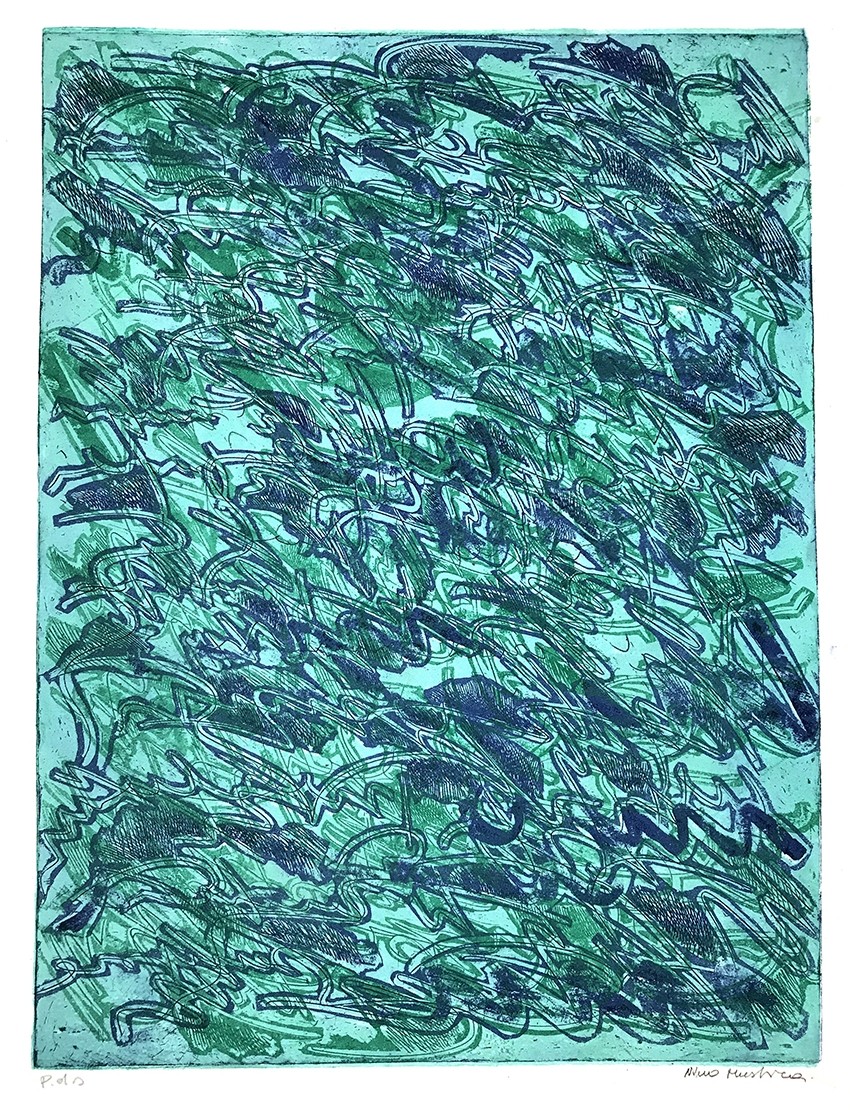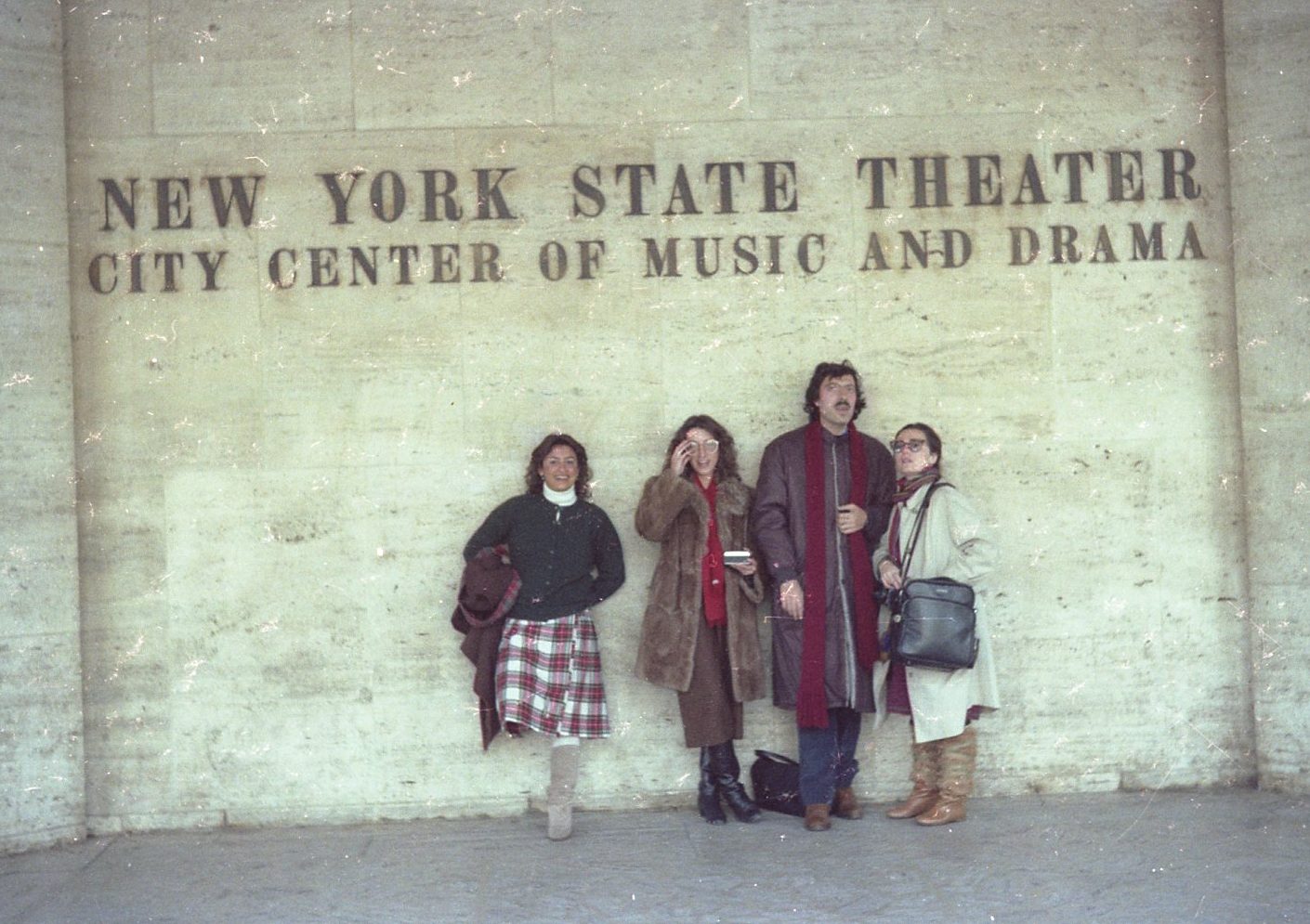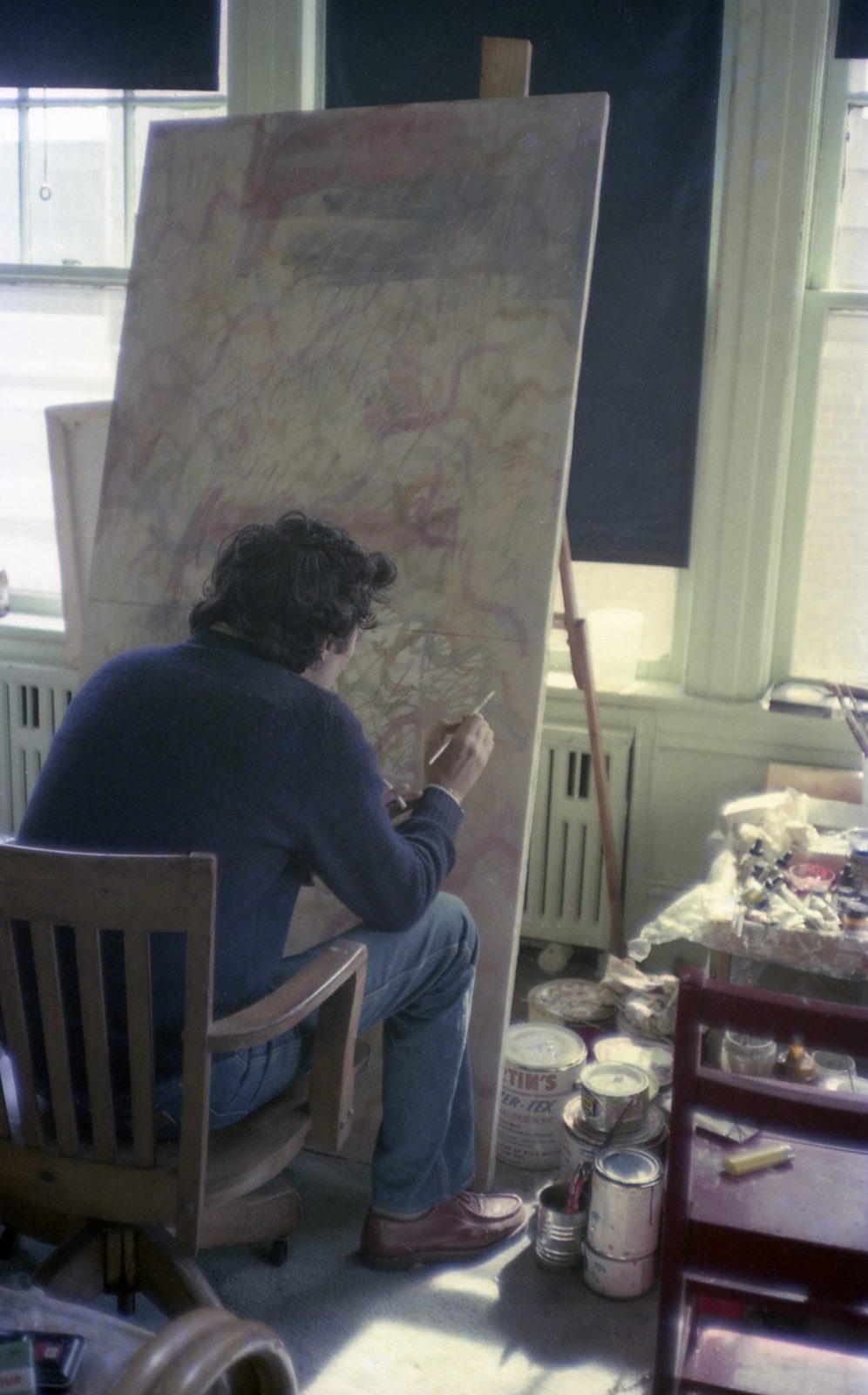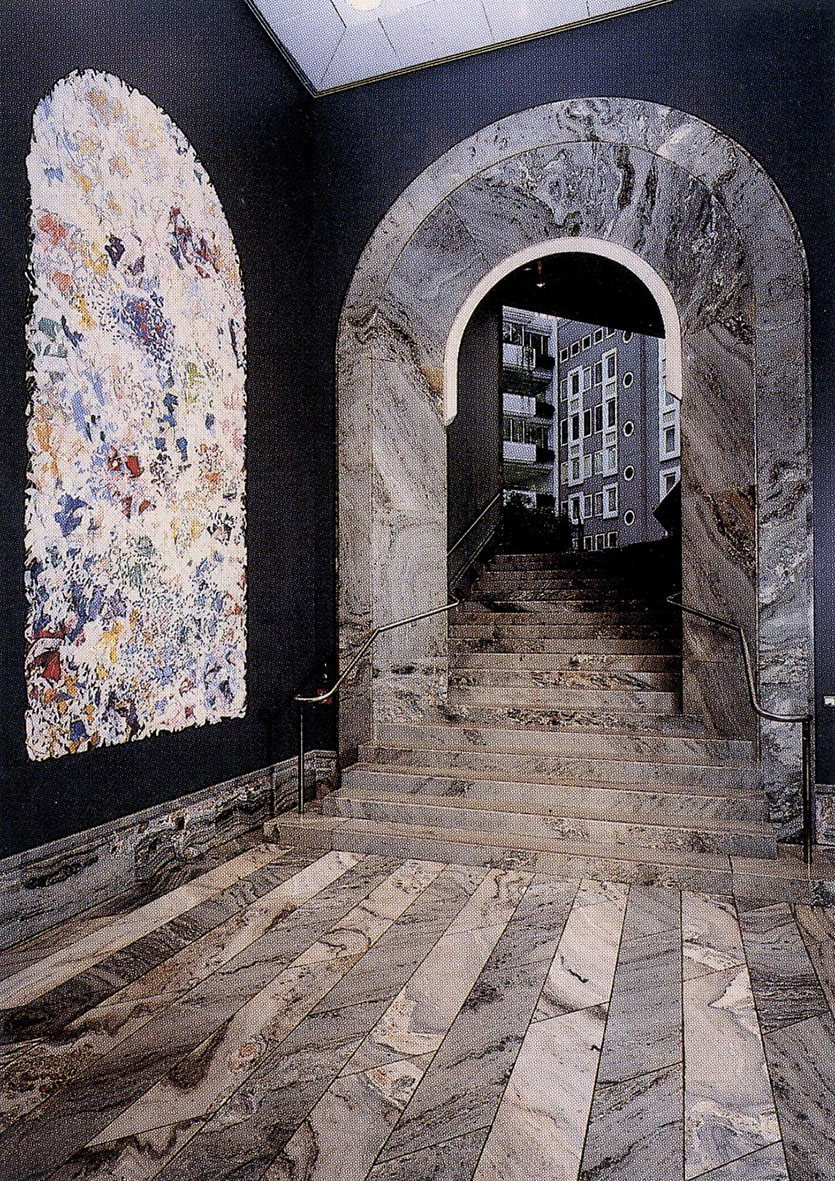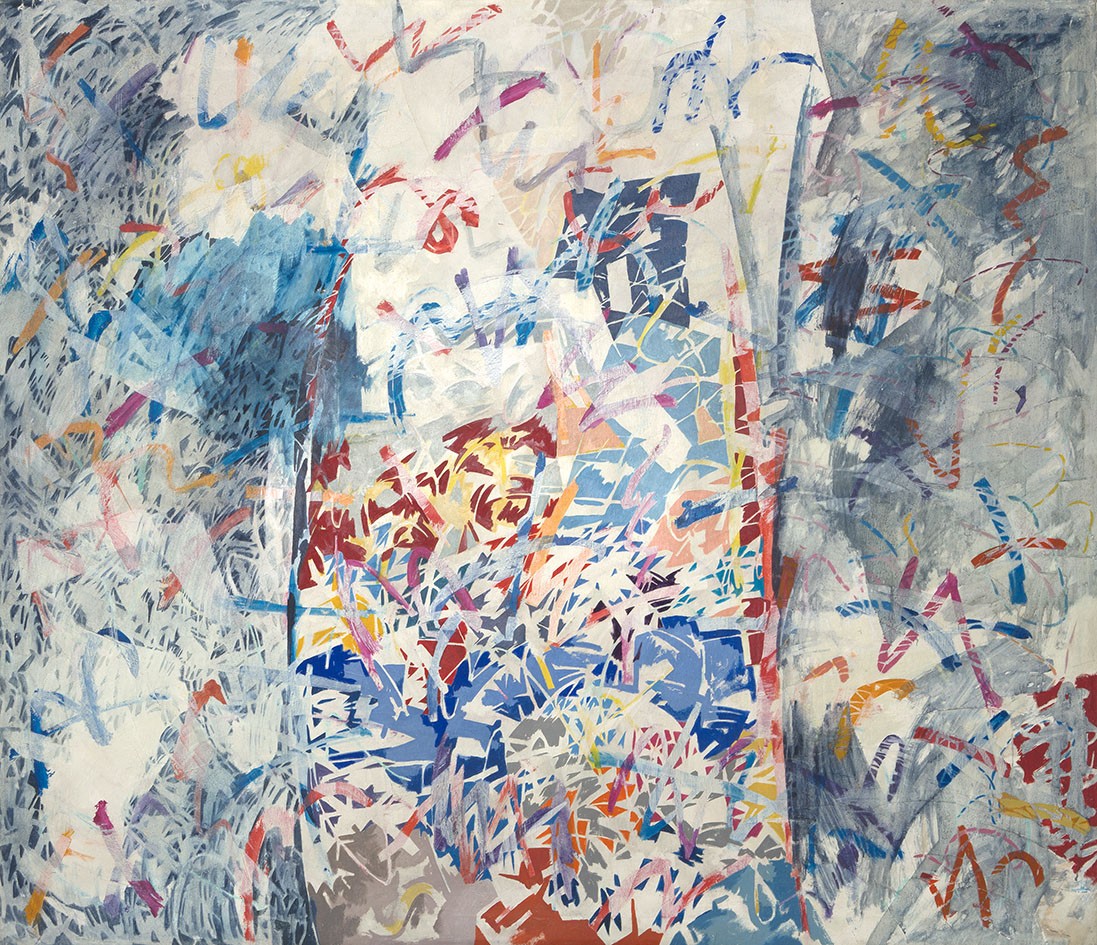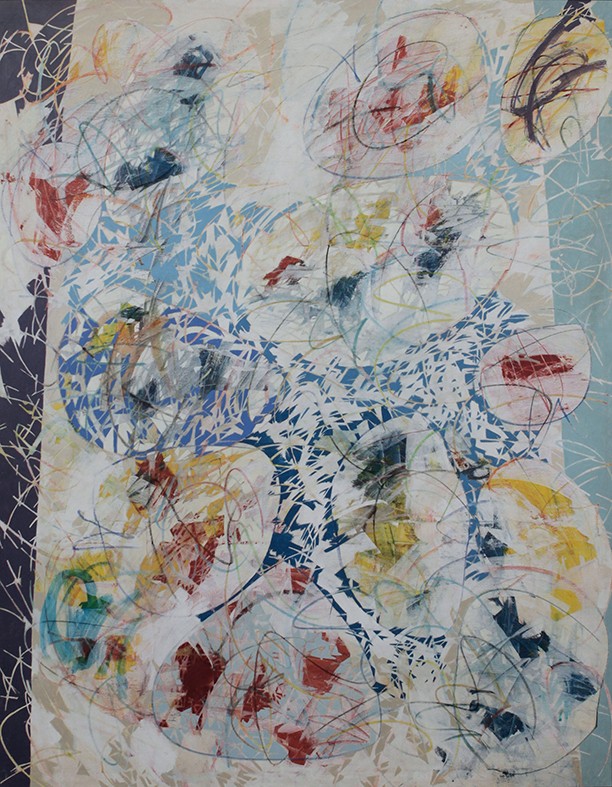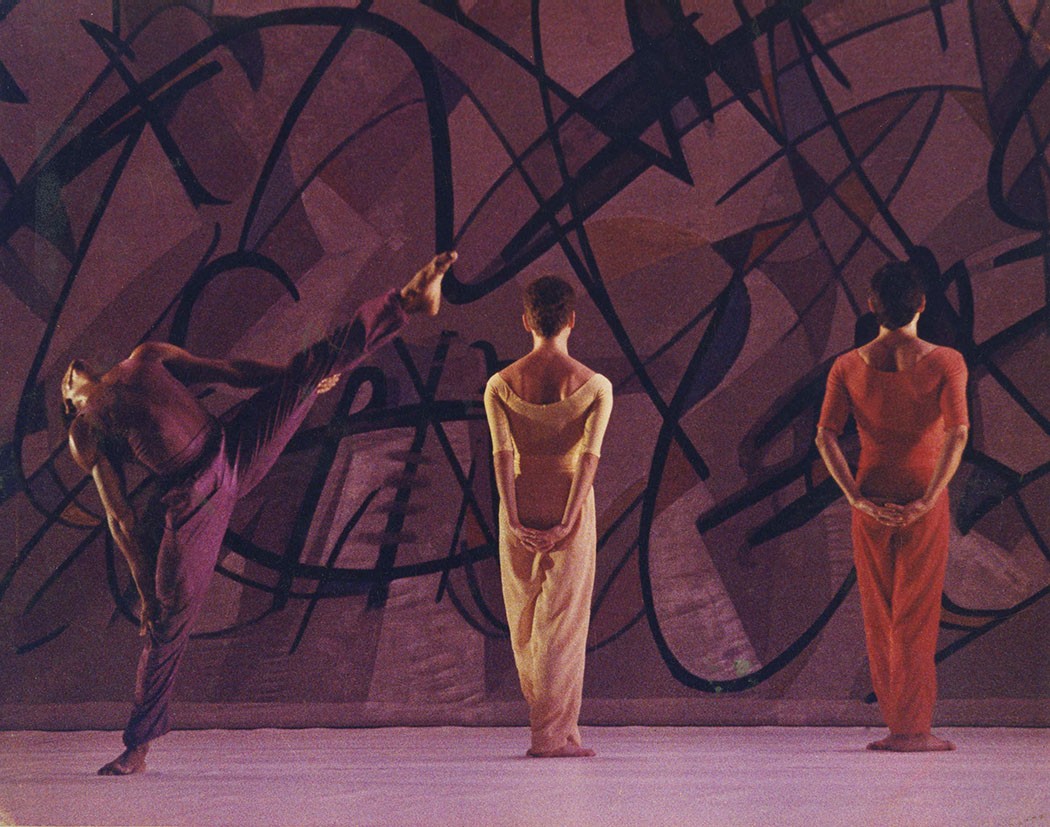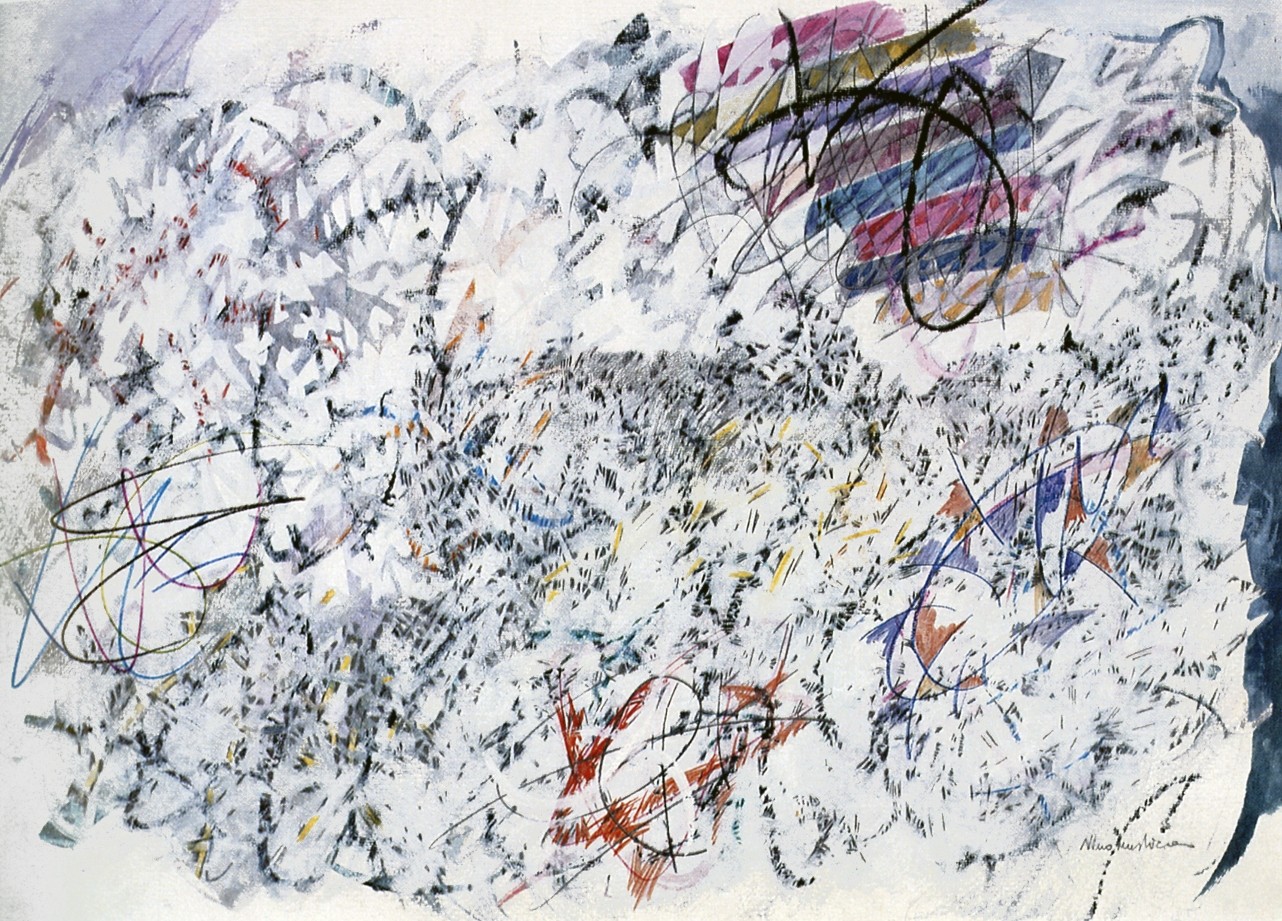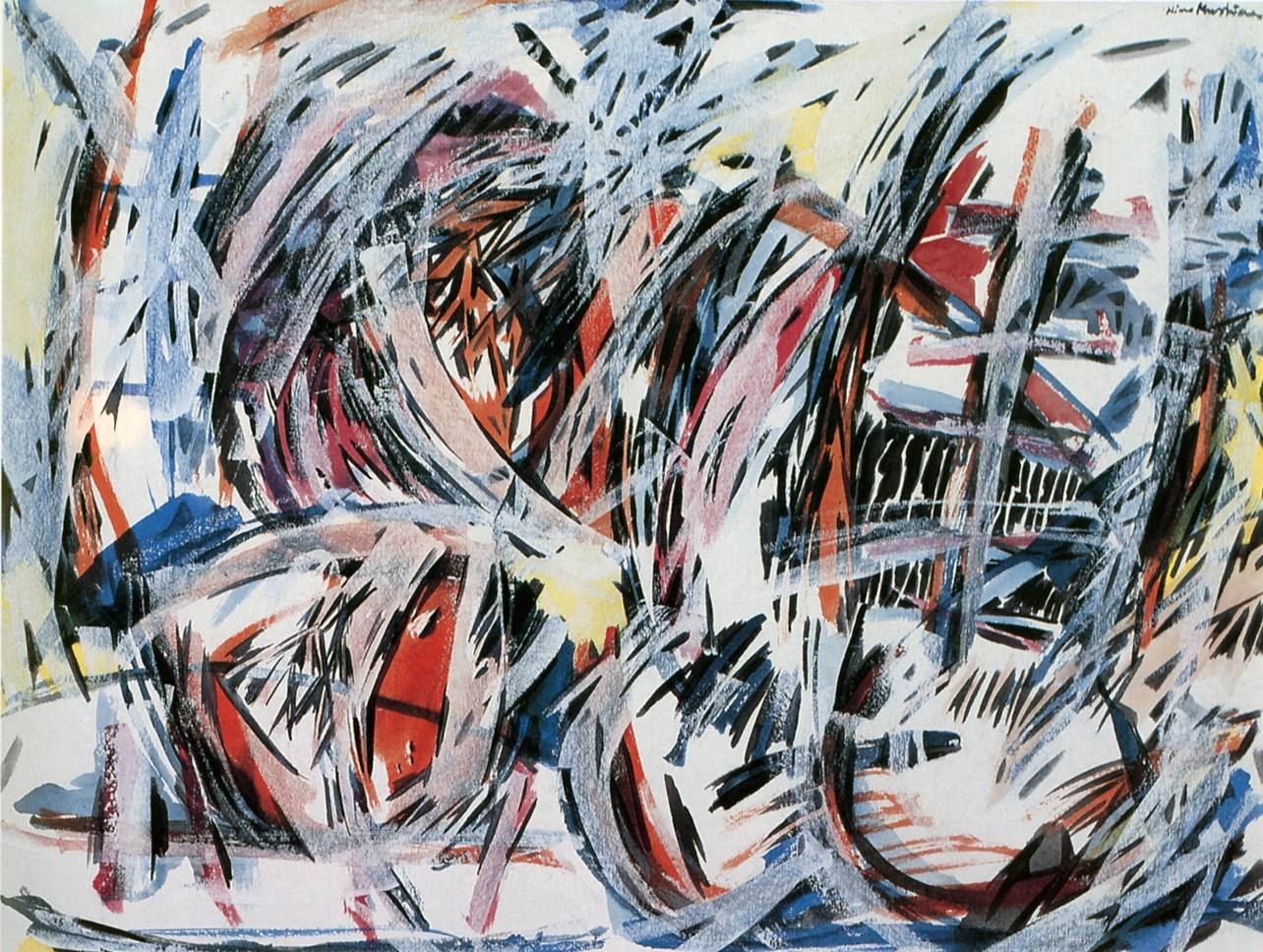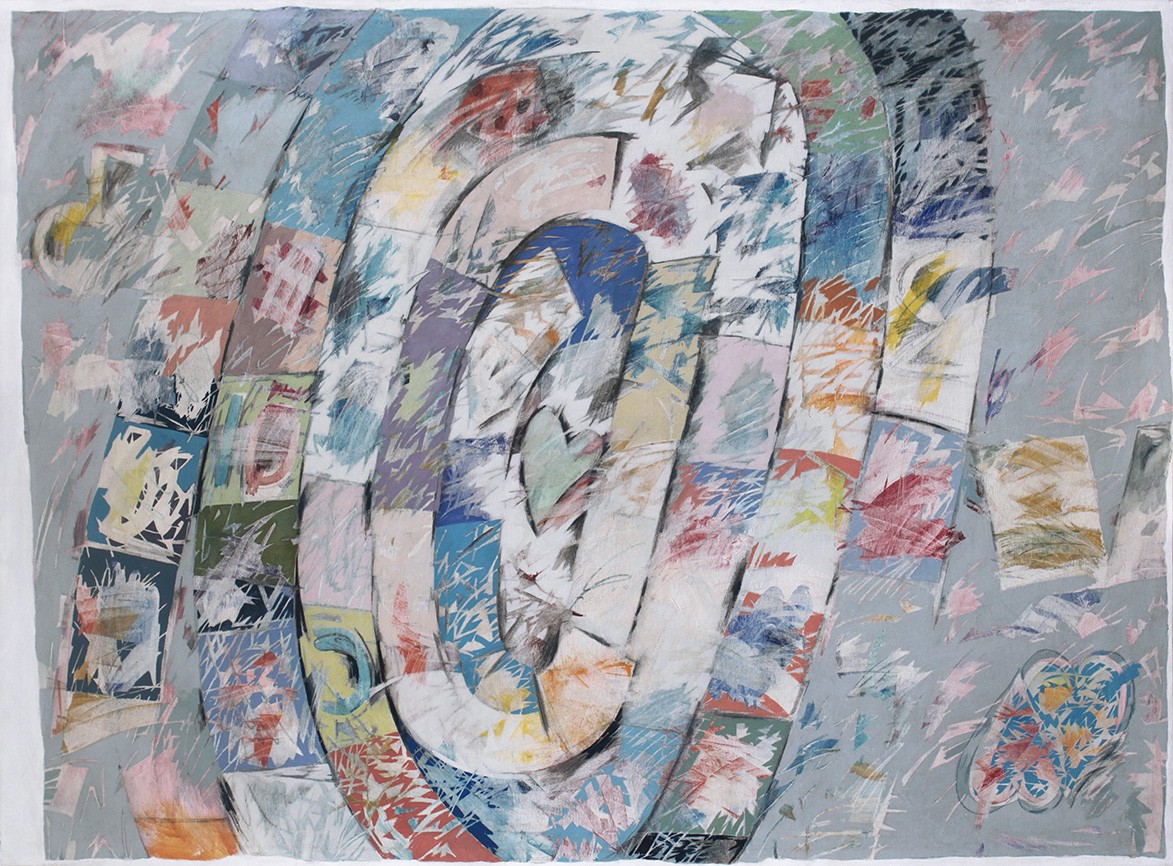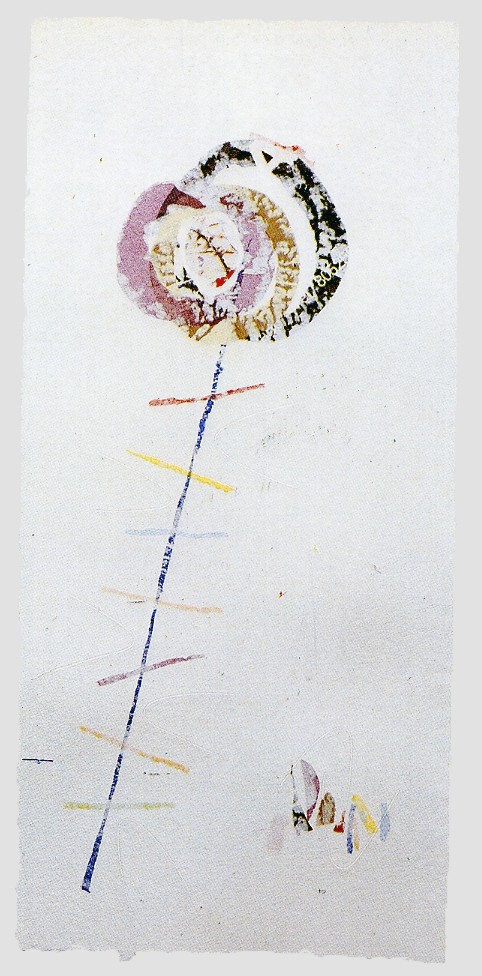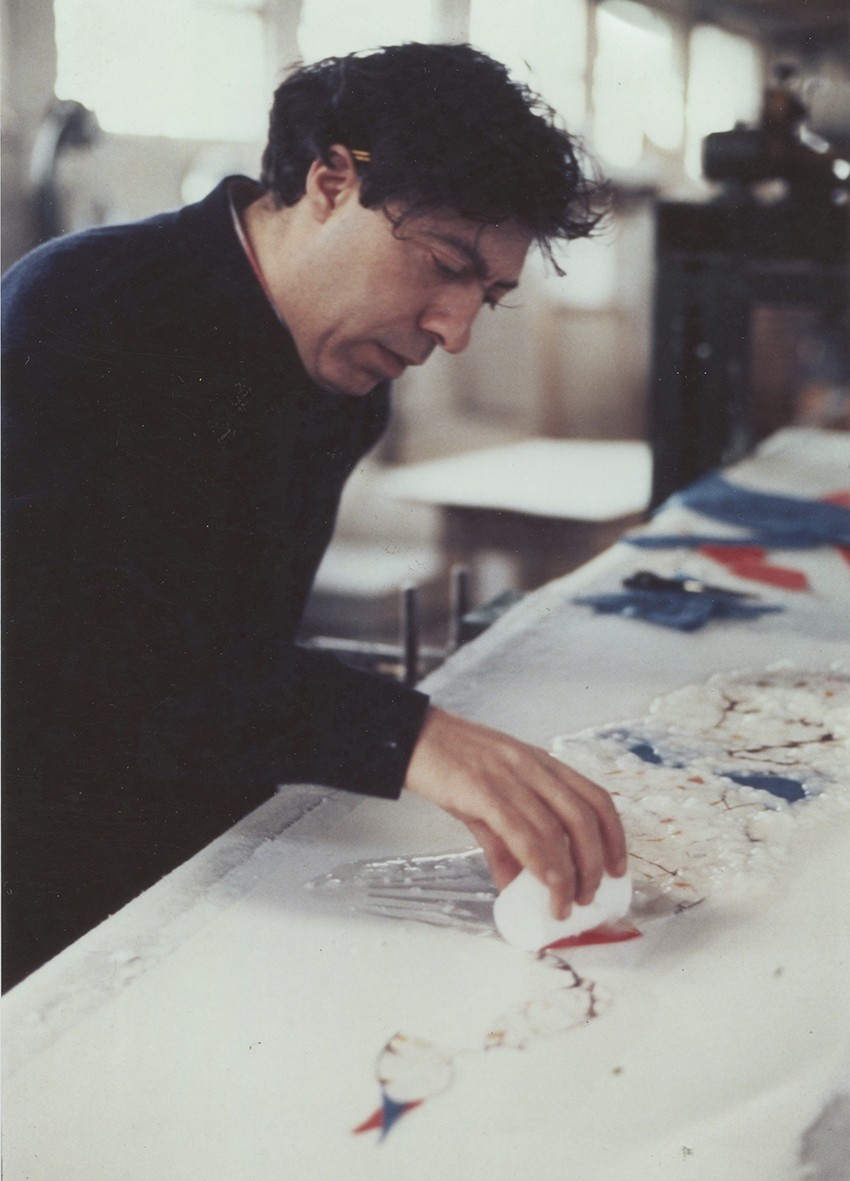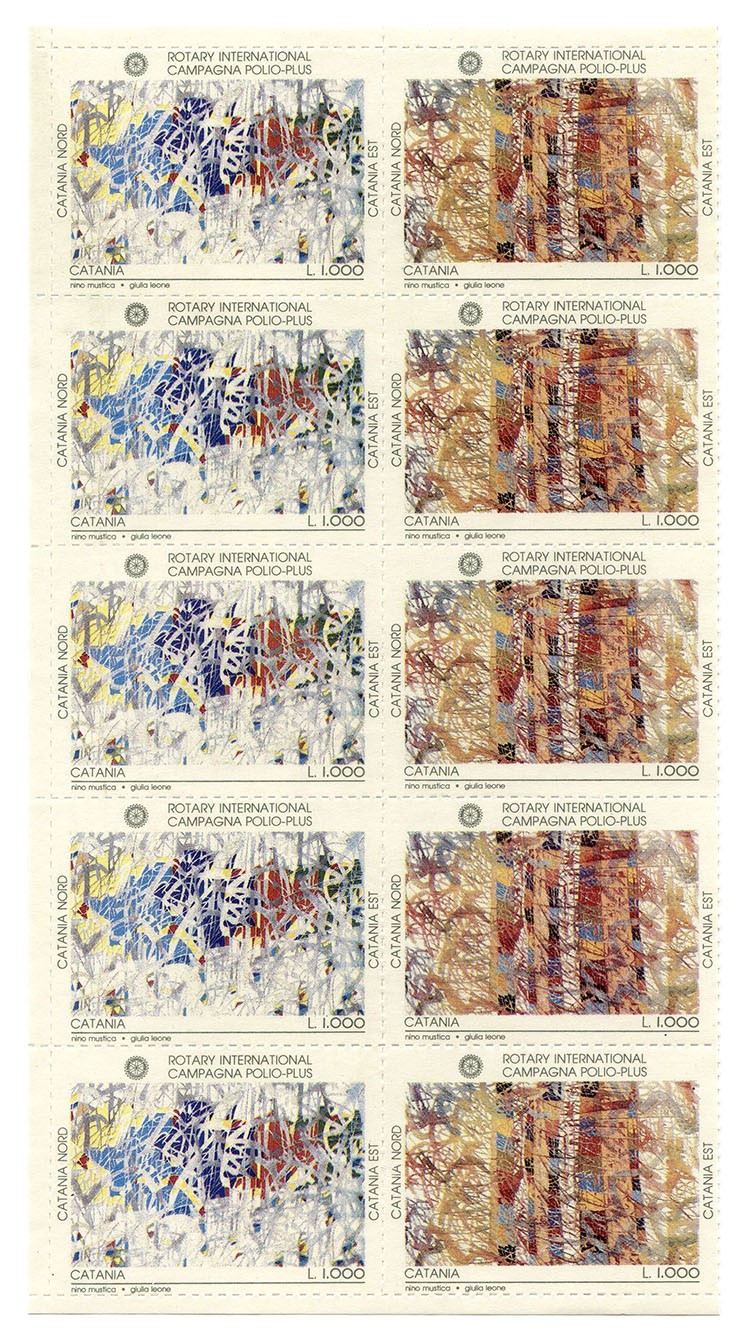1980 - 1989
The eighties were a time of travel, experimentation and exploration for Nino Mustica. Thanks to exhibitions and large-scale events, he travelled several times to Germany (to Munich and Kassel, for example), Greece, Turkey and Spain, leaving Sicily by car with a small group of friends.
In his works from this period, he reflects on the four fundamental elements of abstraction: sign, gesture, colour, matter.
-
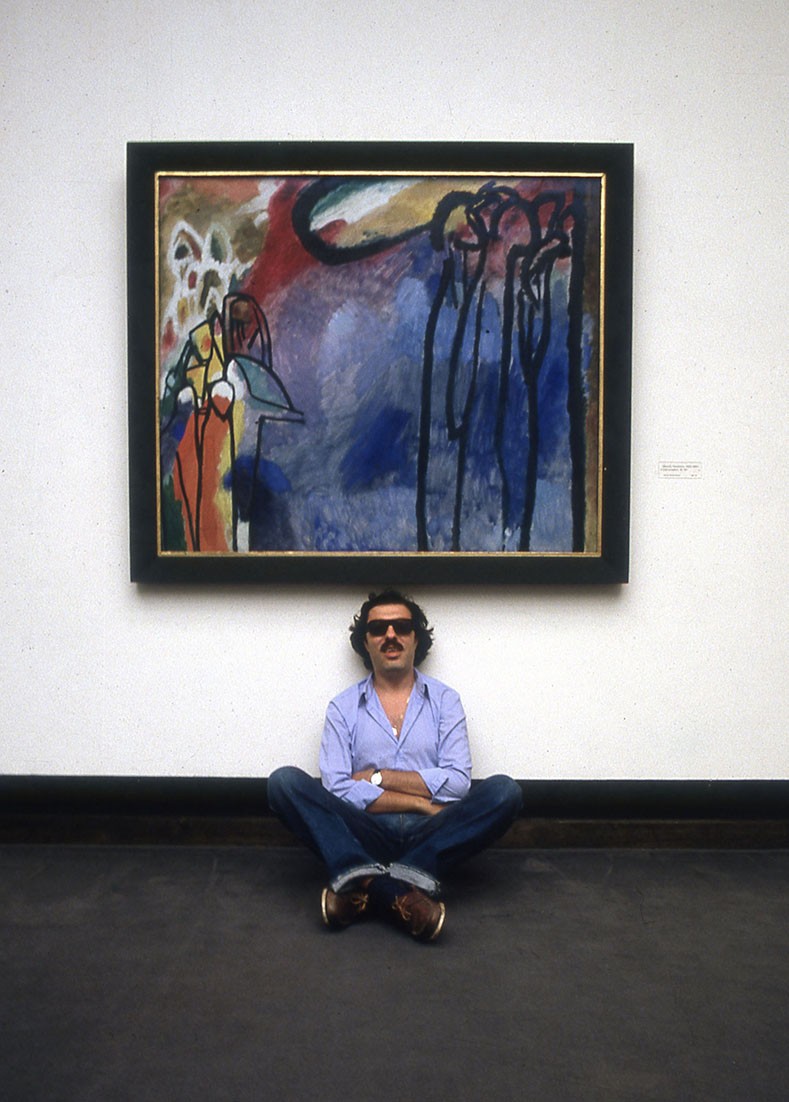
Nino Mustica durante un suo viaggio a Parigi al Centro Pompidou seduto davanti a un opera di Kandinsky, anni ottanta. 1980 → -
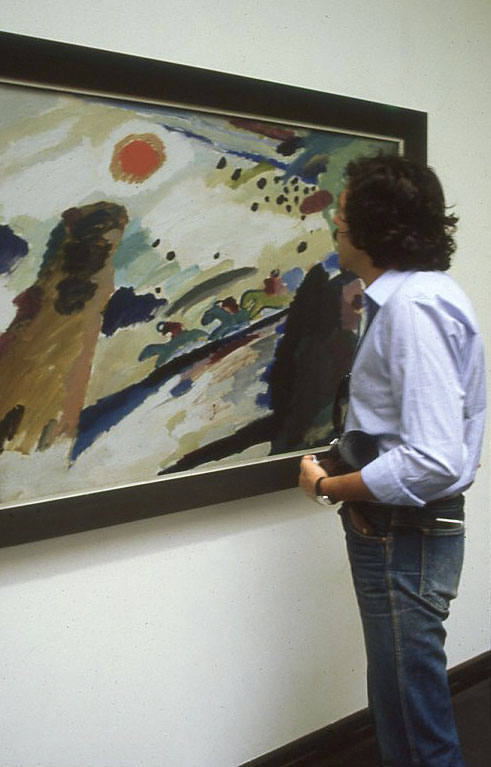
Nino Mustica davanti a un opera di Kandinsky, Lenbachhaus, Monaco, anni ottanta. 1982 → -
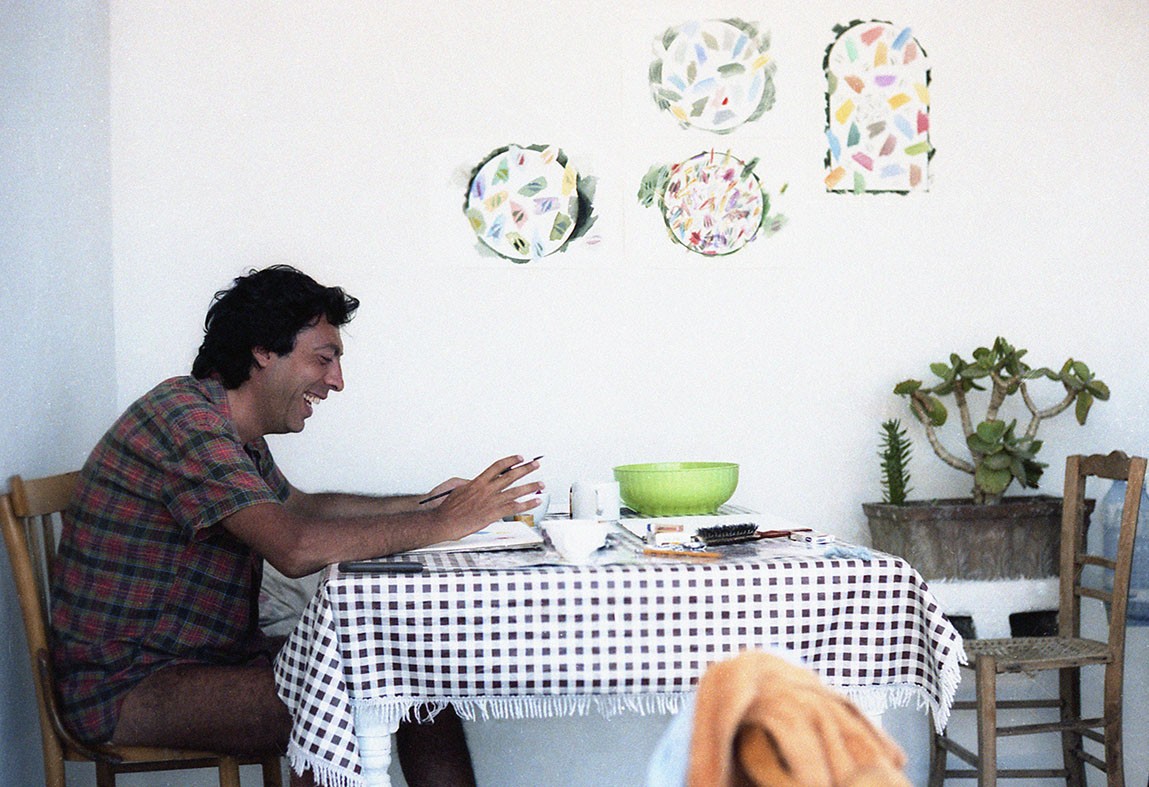
Nino Mustica durante un viaggio a Panarea al lavoro per il affresco della Dresdner Bank, Düsseldorf. 1984 → -

Nino Mustica nel suo studio a Catania, anni ottanta. 1986 →
But let’s go back to the eighties, when the Sicilian artist calibrated and merged the four characters of abstraction: sign, gesture, colour, matter. His canvases framed an imaginary world of increasingly dense signs that were unleashed in informal gestures, in ranges of contrasting colours, in complex networks where form grew from accumulation, from full and empty spaces, from spatial and temporal interlocking. This was where the author’s critical position was defined: he valued the mark of Giuseppe Capogrossi, the gesture of Lucio Fontana, the colour of Giulio Turcato, the material of Alberto Burri. It is no coincidence that he referred to the highest generations, certainly a must for many but often misinterpreted by those who did not go beyond the reference. Mustica metabolised those lessons, instilling something anomalous and deviant within them. A real quadruple leap compared to the linguistic codes of the archetype. His work set the four characters of the abstract tradition together, incorporating the values of each in the visual rhythms of the others.[i]
His canvases framed an imaginary world of increasingly dense signs that were unleashed in informal gestures, in ranges of contrasting colours, in complex networks where form grew from accumulation, from solids and voids, from spatial and temporal interlocking.[ii]
His references are Giuseppe Capogrossi, for the sign; Lucio Fontana for the gesture; Giulio Turcato for the colour; Alberto Burri for the material. The differences and the re-elaboration are however considerable, because Capogrossi’s black signs, recognisable as a universal logo, are transformed today into a solid brushstroke that encloses the personality of the Sicilian; Fontana’s gestures, clear and absolute, are modified with Mustica in their clarity on flat backgrounds; Turcato’s colour, acid and corporeal, emerges in the dissonances of the extended marks; Burri’s material, classically informal, echoes in the rich but now subtle masses, physical yet ‘electronic’ as in the coloured cellotex of Burri’s recent works.[iii]
The process of tearing and recomposing colour and mark begins. The works show a complex and unstable chromatic fabric (Darei un bacio alla luna, 1982; Atitlan – Guatemala, 1981; Manhattan ‘81, 1981), capable of constantly renewing its rhythms, without approaching the figurative rhetoric of the transavantgarde or the citationism of the anachronists, which in those years were establishing themselves in the art system. It was a conscious, deliberate rejection that made him distance himself from the dominant trends.
In 1980 he exhibited his engravings in Catania, at the Galleria Le Arti.
[i] Gianluca Marziani, Nouvelles realitées, Leda Fletcher Gallery, Geneva, 2003, s.p.
[ii] Gianluca Marziani, Viaggio al centro della donna, in Gianluca Marziani, Mark Ruyters (ed.), Nino Mustica. Within colour 1994-2004, Leda Fletcher Gallery, Geneva, 2004, p. 23
[iii] Ibid., p. 24
Artistic events
1981
A Milano nasce il gruppo di architettura e design Memphis.
Al Centre Pompidou di Parigi inaugura Identité Italienne: L’art en Italie de 1959 à aujourd’hui.
1982
Jean-Michel Basquiat dipinge Boy and Dog in a Jonnypump.
In 1981 the 9th Street Gallery in New York dedicated a solo exhibition to him. It was an opportunity to present a series of canvases, created during a several-month residency in the American city. He experienced difficulty returning to Italy, inevitable due to academic commitments, due to the many stimuli and possibilities allowed by the United States.
The following year, in 1982, he worked in London with Zebra One Gallery, exhibited L’uccello dal becco blu, an abstract fable that unfolds in thirteen paintings on canvas, at the Acireale Thermal Baths, and created a pictorial installation at the Acireale Thermal Baths Park.
Eventi Artistici
1983
Al Palazzo delle Esposizioni di Roma inaugura Una generazione post-moderna, curata da Renato Barilli, Fulvio Irace e Francesca Alinovi.
Alla Galleria d’Arte Moderna di Bologna inaugura L’Informale in Italia, curata da Renato Barilli e Franco Solmi.
Bruce Nauman realizza Know’s Doesn’t Know e Human Nature/Life Death/Knows Doesn’t Know.
In 1983 he was invited to Cardiff to create Cwmni Dawns, a set design for the Jumper Dance Company. His father died later that same year.
In 1984 he met Stefania Giarlotta, who was his partner until 1993, and exhibited at the Kunst Galerie Caecilien Allee in Düsseldorf, where he returned in 1985 to create four large dry wall paintings for the main hall of the Dresdner Bank headquarters, which were so well received that they were followed the following year (1986), with a personal exhibition. On this occasion, he presented a series of large oil paintings and mixed media on canvas. Yvonne Friedrichs, author of the text in the catalogue, compares his work to that of Wassily Kandinsky, Mark Tobey, Julius Bisser, Hans Hartung and Cy Twombly.
Artistic events
1984
Nell’ex-pastificio Cerere di Roma inaugura Atelier a cura di Achille Bonito Oliva, che presenta gli artisti del cosiddetto Gruppo di San Lorenzo.
Alla Galleria L’Attico di Roma inaugura La nuova scuola romana.
A Rivoli (TO) apre il Museo d’Arte Contemporanea, Castello di Rivoli, sotto la direzione di Rudy Fuchs.
Nel Regno Unito si svolge la prima edizione del Turner Prize.
1986 was a particularly significant year because, after exhibiting in Europe and the United States, which allowed him to open up to an international dimension, Mustica chose to move: from Catania to Milan, where he took over a studio at 38 Corso di Porta Ticinese, in the Colonne di San Lorenzo area; then at 7 Via Giovenale. Over time, the studio was enlarged and became a place where people lived and spent time on a daily basis, not only the artist who worked and lived there, but also assistants, friends, artists, students and critics. It is located in a courtyard in the so-called ‘Old Milan’, in what was a convent in 1500, then a workshop, carpentry shop and space for bronze castings. It houses furniture, accessories and design objects by Le Corbusier, Gae Aulenti, Carlo Scarpa, Aldo Rossi, Jarno Saarinen, Achille and Pier Giacomo Castiglioni, which are displayed alongside the work tools. The windows, over six metres high, allow light to enter the rooms, while the rooms and the terrace also house Mustica’s collections, from antique toys to Caltagirone ceramics, as well as succulents and cactus.
My so-called ‘emigration’ to Milan was dictated by a need for comparison, by the desire to measure myself against other artists and to have new exchanges, in short by the need to participate in a phase of historical expression that is naturally better represented by a city like Milan, the only Italian city with a not only European but international scope.
A revolutionary and anti-classical artist, with his profoundly critical proposals regarding the system of knowledge and markets built around contemporary art, he has raised symbols and built asymmetrical towers to challenge an occluded and anti-artistic mentality, fomented by a deviant criticism, fed by demagogic systems. Mustica is one of the few masters in Italy, a point of reference for the new generations eager to experiment with themselves and the world around them. His atelier is a very popular workshop, an important place for young people who come to learn and discover, to construct thoughts by manipulating materials, designing and creating objects together with the maestro, with the desire to tell new stories to their own generation and to those that will follow. Mustica is an uncomfortable person. He is cumbersome because of his contaminating positions, difficult to specify to a critical labourer accustomed to translating art only in an aesthetic reading. This is the real problem when observing a work by the Sicilian artist.[i]
[i] Fortunato D’Amico, op. cit., p. 12
Artistic events
1985
Christian Boltanski realizza il ciclo Monuments.
Martin Disler dipinge Streams of Eros.
1986
A Parigi apre il Musée d’Orsay, su progetto di Gae Aulenti.
A Marfa (Texas) apre al pubblico la Chinati Foundation.
At the end of the eighties, thanks to his experiences in relation to theatre (Cardiff, Lisbon) and his experimentation with materials such as paper, the feeling of depth and the breaking down of planes is accentuated in his works. In 1986 at the Il sale art gallery in Catania he presented a series of drawings and watercolours characterised by a more analytical style, with a greater emphasis on line than colour (Trasparente, 1986; Aspetti, 1985; Velature, 1985). A more personal and private dimension, in which critics (texts by Giuseppe Frazzetto, Nicola Moncada and Daniela Fileccia) read references on the one hand to Klee and Kandinsky, and on the other to action painting. He then exhibited paintings and graphics at the Lu Austoni gallery in Milan and presented an exhibition of paintings at the invitation of the Municipality of Valverde, Pavia.
Artistic events
1987
A Trento e Rovereto viene istituito il MART, Museo d’Arte Moderna e Contemporanea di Trento e Rovereto.
1988
A Prato apre il Centro per l’arte contemporanea Luigi Pecci, sotto la direzione di Amnon Barzel.
Claes Oldenburg e Coosje van Bruggen realizzano Spoonbridge and Cherry.
1989
A Parigi viene inaugurata la Pyramide du Louvre, progettata da I. M. Pei.
Si conclude la prima fase di realizzazione del Grande Cretto di Alberto Burri a Gibellina.
In 1987 he designed two stamps for the Polioplus campaign commissioned by Rotary International and exhibited at the Lauro Jaccarino Arte Moderna gallery in Noventa Padovana.
In 1988, at the invitation of the Calouste Gulbenkian Museum of Modern Art in Lisbon, modern dance section, he created a 172-metre set for the show Movimento para uma tela by choreographer Jonathan Lunn, performed in Porto, Lisbon, Cairo and Cannes.
At Studio 15, in Milan, in 1989 he presented carta più carta, curated by Cesare Caini with a presentation by Giorgio Verzotti, a series of works in which he inserts fragments of other papers (tissue paper, printed paper, sometimes fabric such as tulle or silk) into the paste and these are then incorporated into the new sheet of paper. In many cases the fragments derive from previous works and are inserted in a circular or linear manner, underlined by curvilinear incisions (Punto interrogativo, 1988; Fiore di cactus, 1989). The colours are even more delicate than the paintings. They are mostly vertical and rectangular. In the same year, he exhibits graphics at the F.R.M. bookshop in Catania.





